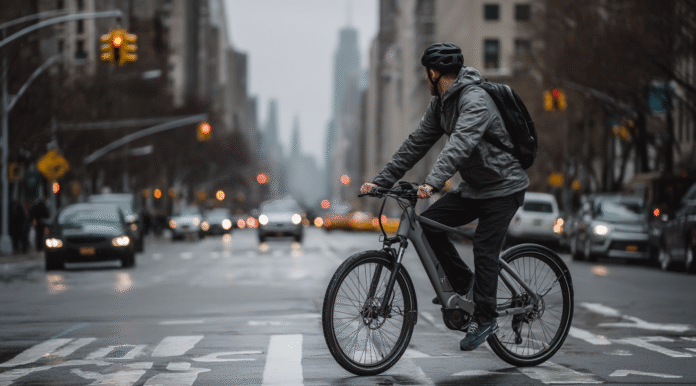Did you know that nearly 40% of all electric bicycle laws in America follow California’s pioneering framework? Since 2015, when Assembly Bill 1096 changed E-bike Laws in California, riders have had clearer rules. They also have more access to public roads and trails.
The bill said electric bicycles are bikes with working pedals and motors up to 750 watts. This law created a three-tiered classification system. It shows different types of motorized assistance. Most electric bicycles follow the same traffic laws as regular bikes.
Knowing legal e-bike classifications is important, whether you’re commuting or exploring trails. The rules balance safety with the growing popularity of these eco-friendly vehicles. For riders across the state, knowing where and how you can legally ride prevents fines and ensures a worry-free experience.
This guide will help you understand the specific requirements for each class of electric bicycle. It will also explain how California’s e-bike rules affect your riding options. We’ll cover everything from helmet requirements to age restrictions and where you can ride.
Key Takeaways for E-bike Laws in California
- California established comprehensive electric bicycle laws in 2015 through Assembly Bill 1096
- Electric bicycles are defined as having functional pedals and motors up to 750 watts
- California uses a three-tiered classification system that many other states have adopted
- Most electric bicycles follow the same road rules as conventional bikes
- Different classifications determine where you can legally ride your electric bicycle
- Understanding these regulations helps ensure safe and legal riding experiences
California’s E-bike Classification System Explained
Understanding California’s e-bike laws starts with knowing the state’s three-class system. This system sorts electric bicycles by their use. It’s based on California Vehicle Code Section 312.5. Knowing your e-bike’s class is key because it tells you where you can ride and what safety rules you must follow.
Defining an Electric Bicycle in California
In California, an electric bicycle has pedals that work and a motor under 750 watts. This rule is critical because it sets e-bikes apart from more powerful vehicles like mopeds or motorcycles. These need different licenses and registrations.
The 750-watt limit is the top for all e-bike classes in California. Anything more powerful is in different categories with stricter rules.
“An ‘electric bicycle’ is a bicycle equipped with fully operable pedals and an electric motor of less than 750 watts.”
California’s definition also requires e-bikes to be like regular bikes. They must have pedals that can move the bike without the motor’s help.
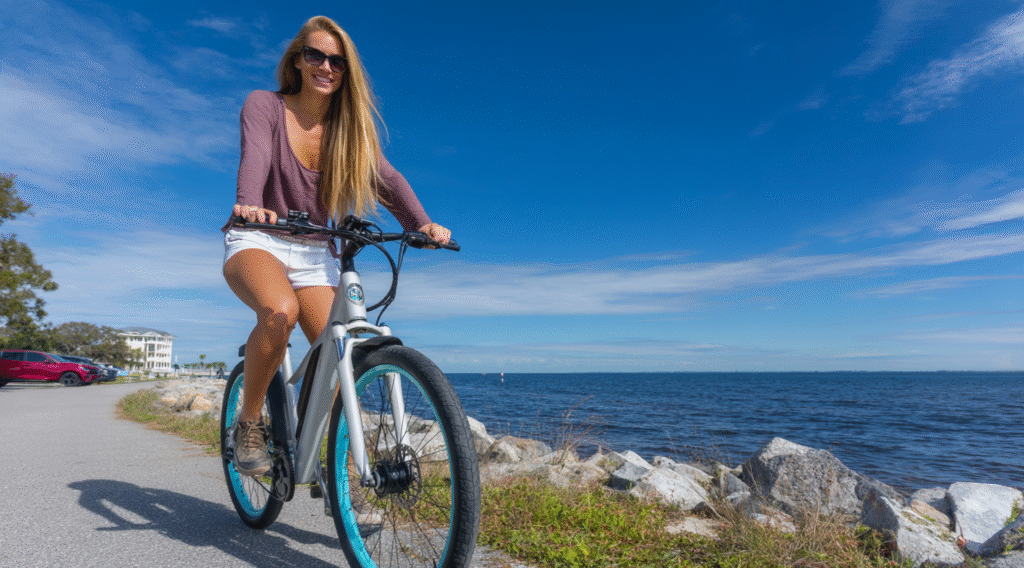
Class 1 E-bikes: Pedal-Assist
Class 1 e-bikes only help when you pedal. They go up to 20 mph with the motor’s help, then stop. This makes them feel like regular bikes with a boost.
These bikes are great for those who like to pedal. They make hills and long rides easier. You still pedal, but the motor helps a lot.
Class 1 e-bikes can go almost anywhere bikes can. This includes most bike paths, lanes, trails, and roads.
Class 2 E-bikes: Throttle-Assist
Class 2 e-bikes have a throttle for extra power. They also go up to 20 mph with the motor’s help. This makes them good for riders who need a break or have physical challenges.
The main difference is the throttle. It lets you move without pedaling. This is great for those who can’t pedal or want to rest while moving.
Even with a throttle, Class 2 e-bikes can ride in most places like Class 1. But, some places might have special rules for these bikes.
Class 3 E-bikes: Pedal-Assist with Higher Speeds
Class 3 e-bikes are like Class 1 but go faster—up to 28 mph. They must have a speedometer for riders to know their speed. This is important for safety.
These bikes are faster, so they have more rules. Riders must be 16 or older, and everyone must wear helmets. This is because they can go faster.
Class 3 e-bikes can’t ride on most paths and trails. They’re prohibited unless local rules say it’s okay.
| Feature | Class 1 | Class 2 | Class 3 |
|---|---|---|---|
| Assistance Type | Pedal-assist only | Throttle-assist | Pedal-assist only |
| Maximum Speed | 20 mph | 20 mph | 28 mph |
| Speedometer Required | No | No | Yes |
| Access Restrictions | Minimal | Minimal | More restricted |
| Minimum Rider Age | None specified | None specified | 16 years |
Knowing about California’s e-bike classes is key for safe riding. Each class balances fun with safety. This system helps keep e-bikes a green way to get around.
When you buy an e-bike in California, it must show its class, max speed, and motor power. This makes it easy to know where you can ride and follow the rules.
As e-bike laws change in California, knowing your bike’s class is more important. It helps you enjoy riding while following the law.
Licensing
In California, e-bike licensing has fewer rules, making them easy to use. Unlike cars, e-bikes have fewer rules, which is great for many people. Knowing these rules helps you enjoy using e-bikes more.
No Driver’s License Required for E-bike Operation
Riding an e-bike in California is easy because you don’t need a driver’s license. This is good for people who can’t get a license for various reasons.
All e-bike classes, including the fastest ones, don’t need a license. This means you can ride a Class 3 e-bike up to 28 mph without needing a license.
But, you must follow all traffic laws when riding an e-bike. This is important for everyone’s safety.
E-bikes Exempt from Vehicle Registration and License Plates
California law doesn’t require e-bikes to be registered like cars or motorcycles. This means you don’t need to register your e-bike with the Department of Motor Vehicles or show license plates.
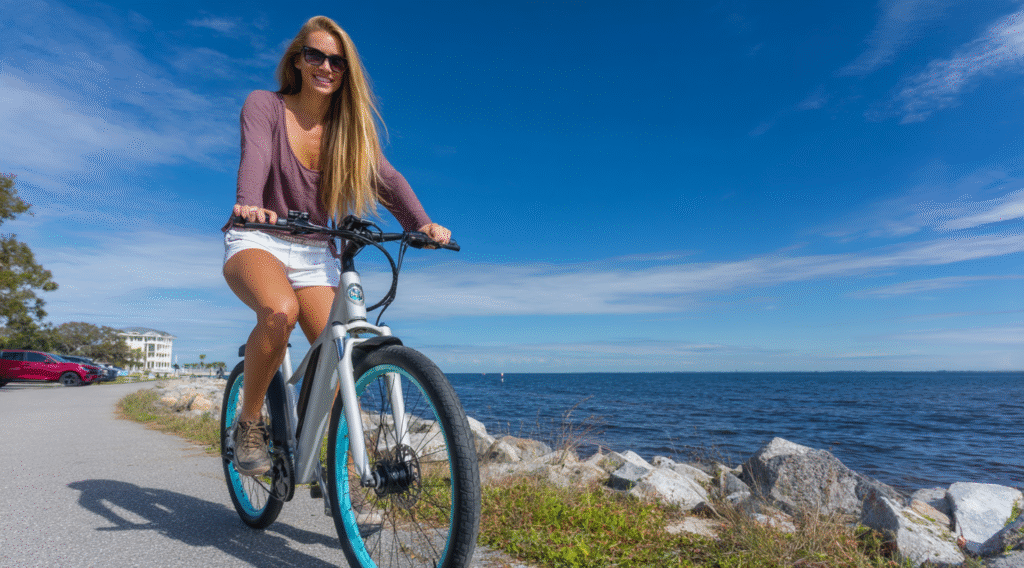
This makes owning an e-bike simpler. You won’t have to deal with DMV paperwork or pay fees. Just buy your e-bike and start riding without the hassle.
According to California Vehicle Code §24016, all electric bicycle classes are exempt from motor vehicle financial responsibility, driver’s license, and license plate requirements.
California’s Stance on E-bike Insurance Requirements
California doesn’t require e-bike insurance like cars or motorcycles. This saves money for e-bike owners.
Even so, getting some form of e-bike insurance might be smart. Accidents can happen, and insurance can help protect you financially. Your homeowners or renters insurance might cover e-bike use, but it depends on your policy.
Some insurance companies offer e-bike insurance. It can cover:
- Liability for injuries or property damage
- Theft protection
- Damage coverage
- Roadside assistance
It’s a good idea to talk to your insurance provider about your coverage. They can help you find the right e-bike insurance.
Understanding Manufacturer Labeling Requirements
California law requires e-bikes to have labels. These labels help riders, police, and trail managers know what kind of e-bike it is. They are key to following the rules.
All e-bikes sold in California must have a label. It should show:
- The classification number (Class 1, 2, or 3)
- The maximum motor-assisted speed
- The motor wattage (which must be less than 750W)
These labels must be easy to see on the e-bike frame. For Class 3 e-bikes, which have special rules, the label is especially important.
Changing or removing these labels is against the law. Also, changing an e-bike’s speed or class without updating the label is illegal. It can affect where you can ride.
The labels help ensure e-bikes are used in the right places. This makes roads and trails safer for everyone.
Age Restrictions for Riding E-bikes in California
Before letting younger riders hop on an e-bike in California, it’s crucial to understand the state’s age-based regulations. These rules aim to balance accessibility with safety. They recognize that higher-powered e-bikes require more skill and maturity to operate safely.
No Minimum Age for Class 1 and Class 2 E-bike Riders
California state law does not specify a minimum age requirement for riders of Class 1 and Class 2 e-bikes. This means that, technically, riders of any age can legally operate these lower-speed electric bicycles that max out at 20 mph.
This open approach gives families flexibility when introducing children to e-biking. However, just because it’s legal doesn’t always mean it’s advisable for very young children to ride e-bikes independently.
Many parents find that Class 1 pedal-assist e-bikes provide a good introduction to electric cycling for older children. These e-bikes help young riders tackle hills and longer distances while still requiring physical effort.
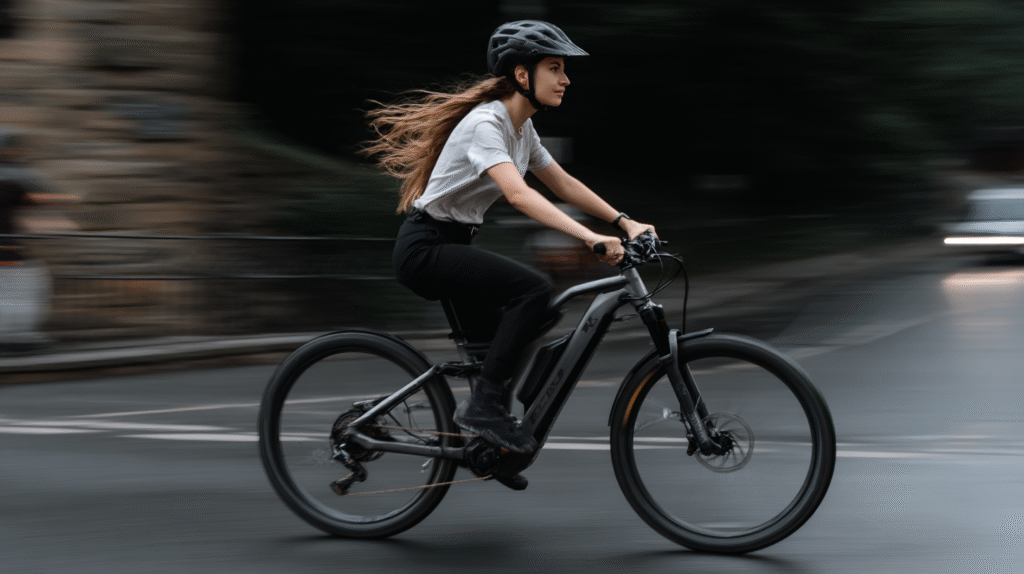
Mandatory Minimum Age of 16 for Class 3 E-bike Operation
When it comes to Class 3 e-bikes, California law is much more specific. You must be at least 16 years old to legally operate a Class 3 electric bicycle in California. This restriction applies without exception throughout the state.
The age requirement for Class 3 e-bikes exists because these models can reach speeds up to 28 mph with pedal assistance. At these higher speeds, riders need more developed judgment, coordination, and road awareness to navigate safely among other vehicles and pedestrians.
If you’re under 16, riding a Class 3 e-bike is not just inadvisable—it’s against California law. Parents should be aware that allowing underage riders on Class 3 e-bikes could result in legal consequences.
Parental Responsibility and Guidance for Younger Riders
While state law permits younger children to ride Class 1 and Class 2 e-bikes, parents and guardians should exercise careful judgment. Several factors deserve consideration:
- The child’s physical size and ability to handle the e-bike’s weight
- Their previous experience with conventional bicycles
- Their maturity level and ability to make safe decisions
- Their knowledge of traffic rules and road safety
- The specific riding environment (busy streets vs. protected paths)
Many e-bikes are designed with adult riders in mind and may be too large, heavy, or powerful for younger children to control safely. Some manufacturers offer youth-specific e-bike models that provide appropriate sizing and reduced power output.
For the youngest riders, consider starting with supervised riding in traffic-free areas. Gradually increase independence as skills and judgment develop.
Emerging Local Discussions on Youth Rider Age Limits
While California state law establishes baseline age restrictions for e-bike riders, some local jurisdictions are implementing their own, sometimes stricter, regulations. These local ordinances may set minimum age requirements for all classes of e-bikes in certain areas.
For example, some cities have established pilot programs with specific age restrictions for e-bike rentals or for riding on certain paths. These local rules can override the more permissive state standards.
Before riding in a new area, it’s always wise to check with local authorities about any specific e-bike age restrictions that might apply. This is especially important when planning family outings with younger riders.
Organizations like E-bikes in USA can provide updated information on changing regulations across different California municipalities. Staying informed about these local variations helps ensure your family’s e-bike adventures remain both legal and safe.
Helmet Laws: Who Needs to Wear One and When
It’s important to know when and who needs to wear a helmet on an e-bike in California. The state has rules for helmet use based on age and e-bike type. These rules help keep young riders safe and give adults some freedom.
Mandatory Helmet Use for All Riders Under 18 Years
In California, all e-bike riders under 18 must wear helmets. This rule applies to all e-bike classes. It’s to keep young riders safe from injuries.
Parents are also responsible if their kids don’t wear helmets. This is because young riders are more likely to get hurt.
Experts say helmets are very important. They can cut the risk of head injury by up to 60% in crashes.
Mandatory Helmet Use for All Riders of Class 3 E-bikes
For Class 3 e-bikes, which can go up to 28 mph, all riders must wear helmets. This rule is for both riders and passengers. There are no exceptions.
Class 3 e-bikes are faster. This means there’s a higher risk of serious injury in accidents. Wearing a helmet is crucial at these speeds.
“The higher speeds achievable on Class 3 e-bikes create greater risk during accidents. A properly fitted helmet is your most important piece of safety equipment when riding at these speeds.”
Helmet Recommendations for Riders 18+ on Class 1 & 2 E-bikes
Adults on Class 1 and 2 e-bikes don’t have to wear helmets by law. But, experts still recommend it. They say it’s safer to wear a helmet, even if you’re allowed not to.
E-bikes can go faster than regular bikes. This means there’s more risk in accidents. Wearing a helmet can help reduce this risk.
Many riders choose to wear helmets, even if they don’t have to. They think it’s better to be safe than sorry. E-bikes often go faster than regular bikes, which can be dangerous.
Ensuring Your Helmet Meets Safety Standards
Not all helmets are the same. California’s laws say helmets must meet certain safety standards. Look for labels from trusted organizations when buying a helmet.
A helmet that meets California’s standards will have a label from a group like the U.S. Consumer Product Safety Commission or Snell Memorial Foundation. These labels show the helmet is safe.
It’s also important for the helmet to fit right. It should sit level on your head and not be too tight. The straps should fit snugly around your ears, with just a little room left.
| Rider Age | Class 1 E-bike | Class 2 E-bike | Class 3 E-bike |
|---|---|---|---|
| Under 18 | Helmet Required | Helmet Required | Helmet Required |
| 18 and Older | Recommended | Recommended | Helmet Required |
| Passengers (any age) | Same as rider age rules | Same as rider age rules | Helmet Required |
| Legal Penalty | Fine for violations | Fine for violations | Fine for violations |
Helmets should be replaced every 3-5 years or after any crash. Even if a helmet looks okay after a crash, it might not protect you well anymore.
California’s e-bike helmet laws might seem complicated. But they make sense based on who’s riding and how fast the bike goes. By following these rules, you’ll be safer and legal while riding your e-bike in California.
Where You Can Legally Ride Your E-bike: Paths
California offers many places to ride e-bikes, but knowing where you can ride is key. The state has a system of bikeways and paths with rules for e-bikes. Knowing these rules helps you enjoy your rides safely and legally.
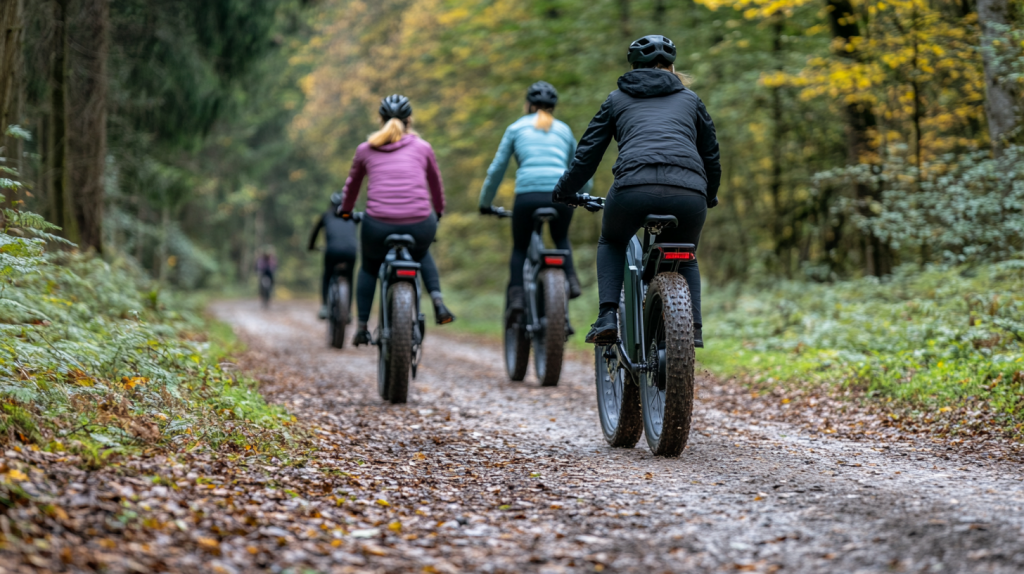
General Access to Roadways and Marked Bike Lanes
All e-bike riders in California have the same rights as regular bikes. All three classes of e-bikes are allowed on public roads where bikes are okay, except where bikes are banned.
Marked bike lanes, or Class II bikeways, are open to all e-bike classes. These lanes are painted on streets and highways.
Class IV bikeways, with barriers like curbs, are for Class 1 and 2 e-bikes. But, some places might not let Class 3 e-bikes in these lanes because of their speed.
Rules for Class 1 & 2 E-bikes on Multi-Use Paths and Trails
Multi-use paths, or Class I bikeways, are for bikes and walkers. These paths are in parks and by water. Class 1 and 2 e-bikes can ride here all over California.
These paths are great for enjoying nature without cars. But, local rules can change things.
“The beauty of California’s multi-use path system is that it provides e-bike riders with safe, vehicle-free routes to explore our state’s natural beauty. Just remember to always yield to pedestrians and keep speeds reasonable.”
When on these paths, ride carefully and follow trail rules. Always give way to walkers, signal when passing, and don’t go too fast.
Restrictions for Class 3 E-bikes on Multi-Use Paths and Trails
Class 3 e-bikes can’t go as fast as Class 1 and 2. California law says Class 3 e-bikes can’t be on Class I bikeways unless local rules say it’s okay.
This rule is for safety. Class 3 e-bikes can be too fast for paths shared with walkers and slower bikes. Always check local rules before riding a Class 3 e-bike on paths.
Some places let Class 3 e-bikes on paths, but with speed limits. Check local websites or transportation departments for this info.
Riding E-bikes on Sidewalks: Understanding Local Prohibitions and Permissions
California state law doesn’t say yes or no to e-bikes on sidewalks. It’s up to local areas to decide.
Some cities let e-bikes on sidewalks in certain areas but not others. For example, Los Angeles allows it in some places but not others. San Francisco says no to e-bikes on sidewalks for those over 13.
Sidewalks are for walkers, so try to avoid riding e-bikes there. If you must, go very slow and always give way to walkers.
California’s Class III bikeways are shared roads with signs but no lanes. All e-bike classes are allowed here. These routes are often quieter and safer for cyclists.
Before you ride in a new area, check local e-bike rules. Many places post their rules online. Or, you can ask local parks and recreation for help. This way, you can avoid trouble and ride legally wherever you go.
Navigating Trails and Parks: State and Federal Land Regulations
E-bikes have access to many trails and parks in California. But, the rules can change a lot depending on where you are. It’s important to know these rules to ride legally and avoid fines.
These rules differ between state parks, national forests, and local areas. So, it’s good to check the rules before you go.
E-bike Access in California State Parks
California State Parks have their own rules for e-bikes. Class 1 and Class 2 e-bikes can use paved roads and bike paths where bikes are allowed. But, they can’t go on unpaved trails or backcountry areas.
Each park has its own rules based on things like how many people visit and the condition of the trails. Some parks might not let e-bikes because of the environment or narrow paths. But, other parks have lots of trails open to e-bikes.

Before you ride, check the California State Parks website or call the park. Park rangers can tell you which trails allow e-bikes and if there are any rules for certain times.
Federal Guidelines for E-bike Use in National Parks and Forests
Federal lands in California have their own rules for e-bikes. In 2019, the Department of the Interior said e-bikes can go where bikes are allowed. This opened up more trails for e-bikes.
In most National Parks, you can ride e-bikes on roads and bike paths where bikes are allowed. But, some parks might still not let e-bikes on certain trails.
National Forests let e-bikes on motorized trails but not on trails for walking or biking. Always check with the forest office or visitor center for the latest rules.
Understanding Local Ordinances for Regional Parks and Open Spaces
Regional parks and open spaces have their own rules for e-bikes. These local ordinances can be stricter than state laws. Some places might not let e-bikes at all or only allow certain types.
In the Bay Area, some places let Class 1 e-bikes on trails, while others allow Class 1 and Class 2. And, some places don’t let e-bikes on their trails at all.
It’s best to check with the park before you go. Parks often post their e-bike rules online or at trailheads. Local bike shops can also help you find out which trails are open to e-bikes.
Prohibitions: Wilderness Areas and Trails Closed to Motorized Vehicles
Some areas are off-limits to all e-bikes. Designated Wilderness Areas are protected and don’t allow any motorized equipment, including e-bikes.
Also, trails marked as closed to motorized vehicles are off-limits to all e-bikes. This rule applies to all e-bike classes, even Class 1.
The rules for e-bikes in these areas are strict. Breaking these rules can lead to big fines. These areas are protected for their natural beauty and wildlife.
When planning your rides, look for trails that are open to e-bikes. Land management agencies are working to make more trails available for e-bikes while protecting the environment.
Operational Rules: Speed
Knowing the speed rules for e-bikes in California is key. You need to understand the limits for each class and follow general traffic laws. This knowledge helps you ride safely and avoid fines.
The state has set clear rules. These rules balance the benefits of electric bikes with safety concerns.
Adhering to Maximum Assisted Speeds for Each E-bike Class
California has set speed limits for each e-bike class. Class 1 and Class 2 e-bikes can get a motor boost up to 20 mph. After that, the motor stops helping, but you can still pedal faster.
Class 3 e-bikes can go up to 28 mph with motor help. They have extra rules because of their speed. These include age limits and where you can ride.
These limits are for the motor’s help, not your total speed. You can go faster by pedaling, but the motor stops at the class limit.
Following All Standard Traffic Laws and Rules of the Road
When riding an e-bike in California, follow the same rules as regular bikes. This means stopping at red lights, yielding to pedestrians, and signaling turns.
You must also ride with traffic and stay right when going slower. E-bike riders must follow posted speed limits, which might be lower than their bike’s top speed. Bike paths often have 15 mph limits for all cyclists.
Breaking these rules can lead to fines and citations, just like for regular cyclists or drivers. Police can give speeding tickets to e-bike riders who go too fast.
Prohibition on Tampering with E-bike Speed or Motor Classification
California law makes it illegal to change your e-bike to go faster than allowed. Tampering with the speed or motor classification of your e-bike is a big no-no. It can lead to serious consequences.
If you make your e-bike too powerful or fast, it might be seen as a moped or motorcycle. This means you’d need a driver’s license, insurance, and DMV registration.
Changing your e-bike without permission can result in fines, penalties, and even having your bike taken away. Sellers and makers can also face penalties for not following California’s rules.
Regulations Regarding Passengers on E-bikes
Whether you can carry passengers on your e-bike depends on the bike’s design and class. Class 1 and Class 2 e-bikes can carry passengers if they’re designed for it.
Class 3 e-bikes specifically prohibit carrying passengers under California law. This is because they can go faster with motor help.
For classes where passengers are allowed, riders under 18 must wear helmets. The rider must also be able to control the bike with a passenger.
| E-bike Class | Maximum Assisted Speed | Passengers Allowed | Helmet Requirements | Special Restrictions |
|---|---|---|---|---|
| Class 1 | 20 mph | Yes (if designed for it) | Required for riders under 18 | Motor works only when pedaling |
| Class 2 | 20 mph | Yes (if designed for it) | Required for riders under 18 | Can operate without pedaling |
| Class 3 | 28 mph | No | Required for all riders | Minimum rider age of 16 |
| Modified/Non-compliant | Varies | Follows moped/motorcycle laws | Required for all riders | Requires registration, license, insurance |
Knowing these rules helps you enjoy your e-bike safely and legally in California. Always check for local rules that might add to these state rules, especially in new areas.
Essential Equipment Requirements for California E-bikers
To ride your e-bike legally in California, you need certain safety features. These laws help keep riders safe and prevent accidents. Knowing these legal requirements for e-bikes is key before you start riding.
Mandatory Lighting for Nighttime Riding
California law is clear about lighting for e-bikes at night. You must have a white headlight visible from 300 feet ahead. This light can be on your e-bike or on your body.
Your e-bike also needs:
- A red reflector on the rear
- White or yellow reflectors on each pedal
- Side reflectors or reflective tire sidewalls
These features are not just legal. They’re also crucial for safety. They help others see you when it’s dark. Many riders add extra lights for more visibility.
Requirement for Functional Brakes on All E-bikes
All e-bikes in California must have working brakes. The law requires brakes that let you stop safely on dry, level pavement. This ensures you can stop when needed.
E-bikes are faster and heavier than regular bikes. Good brakes are very important. Many e-bikes have disc brakes for better stopping power, especially in wet conditions.
Safety should always be your priority when riding an e-bike. Proper braking systems can mean the difference between a close call and a serious accident.
Visibility and Signaling: Best Practices
While not required everywhere in California, visibility and signaling help alert others. Some places require audible signaling devices. Check your local e-bike safety laws.
Hand signals are required for all bike riders, including e-bikers. You must signal:
- Left turns by extending your left arm straight out
- Right turns by extending your left arm up or your right arm straight out
- Stops by extending your left arm down
Reflective clothing or accessories improve visibility, especially at dawn, dusk, or night. These simple steps help you be seen by drivers.
Importance of Regular Maintenance for Safe Operation
Regular maintenance is key for e-bike safety. Check important safety features before each ride.
Your pre-ride safety checklist should include:
- Testing brake function
- Checking tire pressure
- Inspecting battery connections
- Ensuring all bolts and fasteners are secure
Starting in 2026, California e-bike rules will require battery tests and certifications. This aims to reduce battery fire risks and other hazards.
By 2028, rental e-bikes must have certified batteries. This rule protects renters by ensuring bikes meet safety standards. Buying a new e-bike with certified batteries is a wise safety choice.
Following the manufacturer’s maintenance recommendations keeps you safe and extends your e-bike’s life. Many bike shops offer e-bike maintenance services if you’re not comfortable doing it yourself.
Understanding the Impact of Local Ordinances and Future Legislation
California state law sets the stage for e-bike rules, but local laws can differ a lot. Cities and counties can make their own rules, especially about where you can ride.
How City and County Rules Can Differ from State Law
Your hometown might let e-bikes on all bike paths, but the next city might not. Some places limit e-bikes on beach boardwalks, while others welcome them. These differences can change how you enjoy riding an e-bike in California.
The Importance of Checking Local Regulations Before Riding in a New Area
Before you ride your e-bike in a new place, do your homework. Look up local rules. You can call city offices, visit bike shops, or check websites for e-bike laws in California. This can help you avoid fines or tickets.
Awareness of Proposed or Recent Changes to California E-bike Laws
Starting in 2025, California’s e-bike rules will change a lot. Class 1 and Class 3 bikes will only use pedal-assist, and throttles will face new rules. All e-bikes must stay under 750W power. By 2026, e-bike batteries will need safety certification.
Riding Under the Influence (DUI/BUI) Laws Apply to E-bike Operators
E-bikes are not exempt from DUI laws. Riding while drunk can lead to a BUI charge with serious penalties. Always ride sober and safe.
For the latest on e-bike laws across the U.S., visit E-bikes in USA. Laws change often, so always check with local authorities before you ride.


